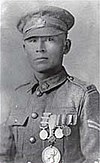Portal:Indigenous peoples of the Americas
Discover Wikipedia using portals
Portal maintenance status: (June 2018)
|
The Indigenous peoples of the Americas PortalCurrent distribution of Indigenous peoples of the Americas The Indigenous peoples of the Americas are groups of people native to a specific region that inhabited the Americas before the arrival of European settlers in the 15th century and the ethnic groups who continue to identify themselves with those peoples. The Indigenous peoples of the Americas are diverse; some Indigenous peoples were historically hunter-gatherers, while others traditionally practice agriculture and aquaculture. In some regions, Indigenous peoples created pre-contact monumental architecture, large-scale organized cities, city-states, chiefdoms, states, kingdoms, republics, confederacies and empires. These societies had varying degrees of knowledge of engineering, architecture, mathematics, astronomy, writing, physics, medicine, planting and irrigation, geology, mining, metallurgy, sculpture and gold smithing. (Full article...) Selected article Ancient Pueblo peoples, Ancestral Pueblo peoples , or Ancestral Puebloans were an ancient Native American culture centered on the present-day Four Corners area of the United States, comprising southern Utah, northeastern Arizona, northern New Mexico, and southwestern Colorado. They lived in a range of structures, including pit houses, pueblos, and cliff dwellings designed so that they could lift entry ladders during enemy attacks, which provided security. Archaeologists referred to one of these cultural groups as the Anasazi, although the term is not preferred by contemporary Pueblo peoples. The word Anaasází is Navajo for "Ancient Ones" or "Ancient Enemy". Archaeologists still debate when this distinct culture emerged. The current consensus, based on terminology defined by the Pecos Classification, suggests their emergence around the 12th century BCE, during the archaeologically designated Early Basketmaker II Era. Beginning with the earliest explorations and excavations, researchers wrote that the Ancient Puebloans are ancestors of contemporary Pueblo peoples. Selected image American Buffalo Gold Bullion coin, based on the Indian Head nickel design of James Earle Fraser, modelled by three different native people, including Iron Tail image credit: United States Mint
General imagesThe following are images from various Indigenous peoples of the Americas-related articles on Wikipedia.
Selected biography Francis Pegahmagabow MM** (March 9, 1891 – August 5, 1952) was the First Nations soldier most highly decorated for bravery in Canadian military history and the most effective sniper of World War I. Three times awarded the Military Medal and seriously wounded, he was an expert marksman and scout, credited with killing 378 Germans and capturing 300 more. Later in life, he served as chief and a councilor for the Wasauksing First Nation, and as an activist and leader in several First Nations organizations. He corresponded with and met other noted aboriginal figures including Fred Loft, Jules Sioui, Andrew Paull and John Tootoosis. Did you know…
SubcategoriesRelated portalsThings you can do
Selected panoramaTopics
Recognized content
Featured articlesFormer featured articlesGood articles
Former good articlesDid you know? articles
In the News articlesAssociated WikimediaThe following Wikimedia Foundation sister projects provide more on this subject:
American indigenous language WikipediasAvañe'ẽ (Warani) · Aymar aru (Aymara) · ᏣᎳᎩ (Cherokee) · Chahta (Choctaw) · ᐃᔨᔫ (Cree) · ᐃᓄᒃ (Inuktitut) · Iñupiak · Kalaallisut (Greenlandic Inuit) · Mvskoke (Muscogee) · Nahuatlahtolli · Diné bizaad (Navajo) · Qhichwa Simi · Tsêhesenêstsestôtse (Cheyenne) Indigenous languages in Wikimedia Incubators: Alabama · Blackfoot · Chinook Jargon · Choctaw · Creek · Lakota · Micmac · Mohawk · Nheengatu · Northwestern Ojibwa · O'odham · Shoshoni · Unami-Lenape · Wüne pakina (Mapudungun) · Yucatec Maya · Central Alaskan Yup'ik · Zuni | |||||||||||||||||||||||||||||||||||||



